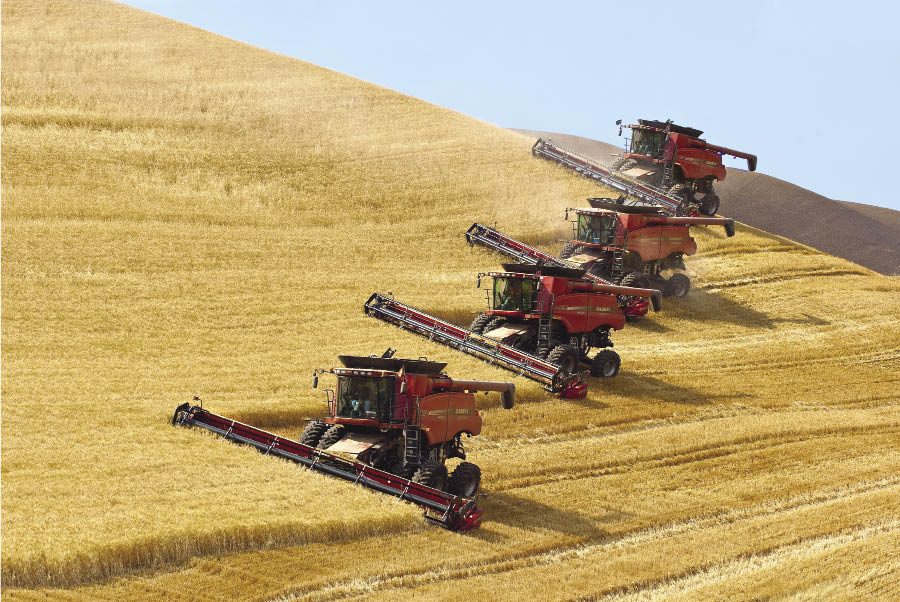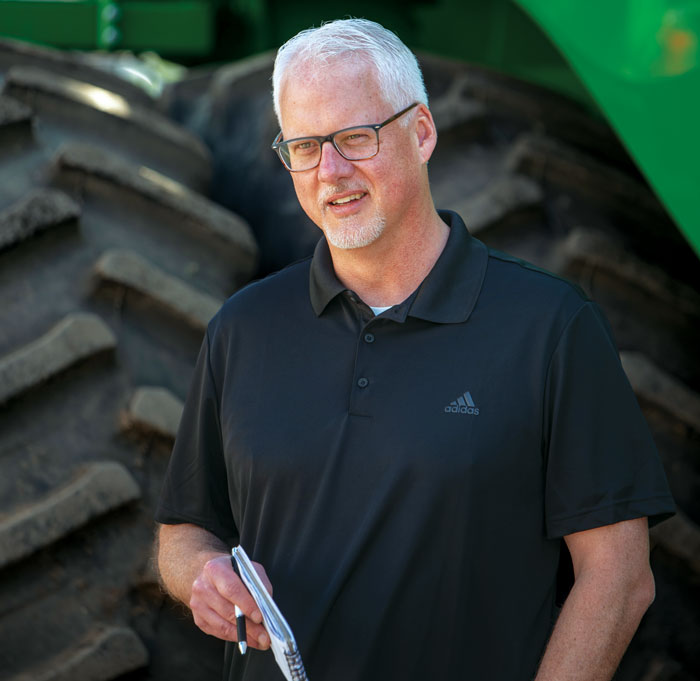Anyone who has ever watched with awe the harvest on the steep hillsides of the Palouse region of the Pacific Northwest knows how critical the combine leveling system is to a farmer’s ability to work the steep hills (up to 60% slopes) and its extremely fertile soils. Without this technology, agriculture, at least cost-effective agriculture, in the region would be severely limited.
But combine leveling is not a solution that is exclusive only for farmers on the majestic slopes. The technology is also dialed-back to sidehill farming, typically described
as 18% (percent is a function of the foot of rise divided by the feet in length to run). As farmers everywhere look to do more with less, the sidehill systems allow farmers to make the transition from “a slow creep around the hills” to high-performance harvesting. Today, more than half of all combine leveling systems are operated in the Midwest, with growth also coming to Pennsylvania, New York, Maryland.
With commodity prices at their current levels, no one wants to see even a stripe of grain loss on the ground — farmers have worked too hard all season long to leave it for the birds or for a volunteer crop the following season.
Hillside combine leveling systems were borne of necessity in the Pacific Northwest (pictured). Sidehill systems are used in less aggressive terrain. Photos and illustrations courtesy Hillco Technologies.
How it Works
Literature from Hillco Technologies, which has a near monopoly on the systems that convert land-leveling combines to sidehill capabilities (including 100% of the systems on Case IH), illustrates what happens when a level-land combine operates on uneven terrain.
With non-leveling systems, the threshed material moves to the low side of the cleaning shoe, allowing valuable air to escape without lifting and separating any crop, resulting in grain loss. “When you get onto a hill and see grain piling to one side, the air escapes, you lose airflow and that grain flows out the back,” says Larry Schliefert, sales manager, Pankonin’s Inc., Louisville, Neb. “You can see a 12-18-inch yellow stripe through the field.”
Hillco’s system is generally “near-factory installed” at sites adjacent to John Deere and Case IH combine manufacturing plants. It explains its system as “moving the original, reliable, transmission-to-final-drive assembly from the combine’s main axle down to the leveling system’s undercarriage.” The combine is lifted 5 inches to accommodate a bolt-on center-pivot system under the chassis to allow a left-right tilt via hydraulic cylinders. An advanced master/slave hydraulic circuit coordinates the rotation between the combine chassis, header and ground to hug the ground during harvesting.
Another alternative is Acculevel Ag Systems (formerly known as RAHCO), which lifts the entire lower side of the combine instead of a center-pivot tilting arrangement. It does not require additional height or a change in balance and turning radius from the as-delivered combine.
Midwestern Dealers
To understand how the technology is being applied in the heartland, Farm Equipment interviewed three Midwestern farm equipment dealers who have been successful in selling sidehill leveling systems to their client base. The dealers include:
 Kurt Miller, sales, Hiawatha Implement, Mound City, Mo. — John Deere dealer Hiawatha stepped into and started promoting sidehill leveling systems as John Deere exited that business in the early 2000s. Of its 26 combine sales last year, 10 were equipped with sidehill leveling systems.
Kurt Miller, sales, Hiawatha Implement, Mound City, Mo. — John Deere dealer Hiawatha stepped into and started promoting sidehill leveling systems as John Deere exited that business in the early 2000s. Of its 26 combine sales last year, 10 were equipped with sidehill leveling systems.
 Terry Snyder, owner, Schenkelberg Implement, Denison, Iowa — John Deere dealer Schenkelberg enjoys a 90% take rate on combine leveling systems, reaching 17 units last year. Since its start with the systems in 2004, the dealership has sold 60 systems, and is also unique in that it does all the installations inhouse.
Terry Snyder, owner, Schenkelberg Implement, Denison, Iowa — John Deere dealer Schenkelberg enjoys a 90% take rate on combine leveling systems, reaching 17 units last year. Since its start with the systems in 2004, the dealership has sold 60 systems, and is also unique in that it does all the installations inhouse.
 Larry Schliefert, sales manager, Pankonin’s Inc., Louisville, Neb. — Pankonin’s, a Case IH dealership, got started in combine leveling systems in 2001 and says 15% of its new combine sales are equipped with the system. While it is not selling as many as in years past, Pankonin’s has sold as many as 5 in a year.
Larry Schliefert, sales manager, Pankonin’s Inc., Louisville, Neb. — Pankonin’s, a Case IH dealership, got started in combine leveling systems in 2001 and says 15% of its new combine sales are equipped with the system. While it is not selling as many as in years past, Pankonin’s has sold as many as 5 in a year.
Sales History
Two events led to the growth of the sidehill market. First, Case IH stopped supplying leveling systems in 1992, which led to Hillco’s entrance into the market. Second, John Deere’s rotary combine launch in 1999 didn’t offer a leveling system. So, customers were seeking a solution on the green combines. In 2006, John Deere produced the last of its walker-model hillside combines. At that point, dealers could satisfy customers only through the leveling system suppliers, who were putting together special third-party installation arrangements with the mainline manufacturers.
Each of the dealers say they entered the niche mostly to take care of existing customers left without a mainline-solution, not necessarily to spread the word to those using land-level combines. “We did sell some to farmers who hadn’t used them previously,” Miller says, “but that was typically because some customers got bigger, and moved into farming the hills for the first time.” Snyder agrees, noting that corn prices led farmers to move up into set-aside acres and pastures, where they discovered a harvesting need they hadn’t seen before.
Pankonin’s, who sells Case IH, got some farmers to switch colors by establishing his sidehill expertise early on, as some green farmers could no longer rely on their major manufacturers alone for sidehill harvesting needs. “We fed quite a few units into the area, and as farmers traded every few years, other farmers noticed and it took off,” says Paul Pankonin, GM.
Formal third-party arrangements with John Deere and Case IH plants exist so that the combine can be fully equipped with the leveling systems prior to dealer delivery.
Lay of the Land
Dealers’ success with combine leveling systems is a matter of reputation and knowledge. None of the dealers interviewed would be described as “active promoters,” but it does give them another talking point.

Above: LEVELING COMBINE. A combine leveling system keeps the grain evenly distributed in the shoe, allowing maximum separation and cleaning capacity.
In fact, Snyder says his dealership doesn’t hunt down prospective farmers for combine leveling systems — they come to them. “Our reputation has grown by word of mouth, and people drive our lots and see 20-30 combines, most of which have sidehill leveling systems. We get guys calling from other states because we’ve specialized with these systems.”
When it comes to the sales process, dealers like to paint the picture of the neighboring farmer who uses them. “The guys who use the machines know they need them and want them,” says Miller. “Particularly with the guys who don’t think they need it, you want to be able to share another farmer’s story. Most don’t think of the impact of speed, the unloading on the go and the productivity that all factor in.”
In initiating an effective discussion, Miller says you’ve got to know the farmer’s land and to what extent it is hilly terrain. “If I know that he’s in the hills, and he wants to stay at the same size combine, I’ll walk him through the pros/cons of a combine leveling system. If a guy is using a 6-row head and going to an 8- or 12-row head, that’s when we start to really focus. And when you get to the 12-row machine, with all that’s going through a combine of that size, it’s even more important to be level to get the full productivity.”
While you can get lucky sometimes, Schliefert finds the odds of selling to a first-timer are far better on the used side. “The guys who want the sidehill systems will stand in line for the combines being traded off. That farmer who goes with the used unit will turn into a new buyer the next time around.”
Attention-Getting Benefits

When discussing combine-leveling technology with prospects, there’s no shortageof selling points, say dealers. Generalities on numbers are difficult to make, however, until you can sit down and enter data into the estimating programs.
Miller and Schliefert agree the grain loss discussion resonates best. “With the grain tank sitting level, you’re not wasting grain or throwing it over the side,” says Schliefert. “We tell them they won’t see 20-30 bushels on the ground on the back slopes of hills.”
Snyder leads with the harvesting speed discussion. “Speed is the biggest factor because everyone is looking to get the crop out as soon as they can. With weather patterns, the window of opportunity for harvest is short. Plus, a lot of guys’ acreages are growing and they must cover them faster because they only have so many days. Productivity is the biggest thing.”
But don’t forget the “operator fatigue” factor. “Especially when farmers who are getting up in years, some can’t even walk after 8 hours in the combine,” says Schliefert. “With one of these systems, they sit level — like they’re sitting in their office chair.” Snyder says some will buy for one reason alone — “they hate sitting crooked in the seat.”
He also likes to discuss how easy and seamless the system is with the combine, with almost no training requirement. “You can’t even tell the leveling system is adjusting because it all blends together,” he says.
Grain loss, harvesting speed, unloading on-the-go and comfort all drive interest in leveling systems. It’s a matter of how effectively the dealer presents all the sales points. Says Miller: “If you know farmers, you know that if you can show them how to save a dime, they’ll spend a quarter.”

Objection: Overruled
No surprise here, but price is a significant obstacle to overcome. Not due to the price of the leveling system (though Schliefert notes it’s risen considerably as combines have gotten bigger) so much as the dramatic increase in the price of combines. “Farmers trading from an older combine will need to spend $100,000 more today, and then you ask them to throw another $40,000 on top of it,” says Snyder.
Plus, there’s competition in newer alternatives — the self-leveling systems (the self-leveling sieve at John Deere and the self-leveling shoe at Case IH) that combine manufacturers offer as a standard feature in today’s combines. “That technology is fairly fresh, and because of the higher priced combines, some are trying it out to save some dollars,” says Schliefert. “When the customer learns that feature exists in his new combine, it seems like you’re stacking features on top of one another. So they don’t think it’s necessary.
“When they find out the self-leveling sieves don’t provide what they’re accustomed to, a lot of growers will turn back to the leveling systems.”
Snyder feels that the risk of sales lost to the automatic systems is on the first-time prospect only. “Once a farmer has invested in a leveling system, they’ll never trade down to a self-leveling sieve. Sidehill system owners can’t tolerate the loss because they’re not used to seeing it. Plus, there’s a capacity sacrifice because of the sieve design, so they lose productivity.”
Peer-to-Peer Demos
Like every other piece of farm machinery, first-hand experience is key. Neither Miller nor Snyder have needed to directly demo the system to sell it, though Snyder says he’s sure they would’ve moved more if they’d allocated the time and money to an aggressive demo program.
Miller and Schliefert both encourage prospects to ride with other customers. “We steer them to see a farmer down the road,” says Miller. “That’s the best scenario; to hop in, ride, see it and feel it. That experience with a current user will sell the product for us.”
As the mainlines promote their own standard systems, Miller’s best sales tool is a customer, Byron Fink. “He opted to go with the standard self-leveling sieve this time around to save money, but experienced grain loss, a considerable loss of harvesting speed and could no longer unload on the go.” He’s back to a leveling system for this year’s harvest.
Schliefert says his dealership has had success with demos, particularly with the farmer who clearly has a need for a leveling system but who has never run one before. He has a couple of pieces of advice. First, he says, don’t let them run a new combine, because the farmer instantly thinks it becomes a used piece of equipment. “We’ll let the used ones out, sometimes renting them for 2 days. That’ll sell it.”
Second, he says, is an important tactical point. “Don’t let your prospect finish the day with your demo unit. Make him get back into his old combine so he can remember how bad it was.”
Boosting Trade Values
Another important point, say dealers, is resale value. Snyder says he doesn’t depreciate the systems at all on trades, and Byron Fink shared that his initial investment in the leveling system simply “rolls over” from year to year. He is only asked to open his wallet if a significant price increase from the manufacturer occurs.
“The value always stays with the combine,” says Snyder of the leveling systems. “If you have two combines next to each other on the lot, the one with the leveling system is worth $25,000 more.”
Miller agrees, noting that used combines with leveling systems always sell better and quicker on the dealer’s lot. “There’s just not that many out there to begin with. The value always remains high.”
The ability to differentiate used combines had a great deal to do with Snyder’s decision to enter the market. “I got started because it was a way to create a niche market within combines. There are hundreds of John Deere combines sitting out there and they’re all the same.”
The leveling system makes a combine unique from the others, and he found people willing to travel long distances to buy a combine that could handle sidehills. He adds that he sells used combines with the systems all over the place, including places as far away as Wisconsin.
What’s Ahead?
Snyder, Pankonin and Schliefert all agree there’s some risk to sales due to the mainlines’ self-leveling sieves and shoes. Snyder thinks they could slow the rate of growth, but he isn’t otherwise concerned. He cites sales growth in the sidehill systems last year and had two farmers trade up from land-level combines for the first time. He also won a color conversion from a farmer who watched his neighbors’ success.
“I look for our leveling system sales to grow in the next 2-3 years,” he says. “Every year, we spread out a little farther, get more out-of-state calls.”
Miller, who said the 10 systems sold in 2010 were the most ever, says sales are already up for next year. With a $6-7 corn price, that extra bushel lost out the back will get even more attention, something he expects to drive more sales this summer. “Some farmers will move to it because of the higher corn prices,” he says. “But even if prices remain in the $3-4 range, we’ll see more adoption.”








Post a comment
Report Abusive Comment